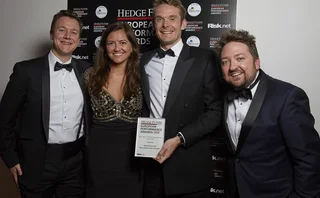
Volcker rule fuels hedge fund launches in 2011
Wall Street’s top traders are swelling the ranks of the hedge fund industry as financial regulators move closer to finalising rules that would restrict US banks from engaging in proprietary trading.

Section 619 of the recently enacted Dodd-Frank Wall Street Reform and Consumer Protection Act generally prohibits US commercial banks from engaging in proprietary trading, vaguely defined as taking positions in the market with their own capital with a view to scoring profits.
The Financial Stability Oversight Council, the agency tasked with implementing and enforcing many aspects of the act, is finalising the rules on proprietary trading. Meanwhile many of the biggest US banks have decided to disband their internal trading desks before the axe falls.
The hedge fund industry is the biggest beneficiary of the exodus from the banks.
Former traders from Goldman Sachs’ principal strategies desk are expected to pull off some of the biggest hedge fund launches of 2011.
The first $1 billion launch of the year is tipped to be Azentus Capital Management, an Asia-focused hedge fund led by Morgan Sze, former global head of Goldman’s principal strategies business. Hong Kong-based Azentus is reported to have assembled an investment team that includes 12 former employees of principal strategies.
Some of Sze’s former Goldman colleagues are expected to raise at least $500 million when they launch their hedge funds later this year.
Goldman’s nine-person US principal strategies team led by Bob Howard joined the private equity group Kohlberg Kravis Roberts in October 2010. They plan to launch a long/short equity hedge fund later this year which is expected to attract significant interest from institutional investors.
In Europe an ex-principal strategies team led by Daniele Bonatoff and Ariel Roskis has already secured $300 million in seed capital from Swedish hedge fund sponsor Brummer & Partners for an event driven hedge fund which will be based in London.
The Goldman alumni are following a well-trodden path. Pierre-Henri Flamand, Sze’s predecessor as global head of principal strategies, raised more than $1 billion for London-based Edoma Capital Partners, one of the biggest hedge fund launches of 2010.
Goldman traders who have launched hugely successful hedge funds include Eric Mindich, Dinakar Singh and Cliff Asness, who managed Goldman’s internal Global Alpha hedge fund in the 1990s before launching AQR.
Although it is still difficult to raise launch capital for a hedge fund, former proprietary traders entering the business this year are benefiting from a growing appetite for alternative investments among pension funds and wealthy individuals and families, says Jack McDonald, CEO of Conifer Securities.
“We see a more receptive environment for hedge fund launches in 2011 which bodes well for some of the proprietary trading teams coming out of the investment banks,” says McDonald. “The demand for alternatives has grown across the board. Institutional investors are increasing their allocations, while high net worth investors and family offices are returning to the fold after sitting on the sidelines for the past couple of years.”
Hedge funds attracted $55.5 billion of net new capital in 2010, the highest annual inflow since 2007, according to data from Hedge Fund Research. Of this, over $32 billion was collected in the second half of the year, reflecting the steady increase in demand for hedge funds.
The final months of 2010 also saw a meaningful growth in allocations to smaller managers and startups. Hedge funds with less than $5 billion in assets accounted for almost 50% of inflows in the fourth quarter compared with less than 20% over the previous nine months.
Investors are increasingly willing to back startups with the right background and reputation, although it is still generally harder to secure launch capital than it was before the financial crisis, says Jeff Fulk, an analyst at Signet Group, a $1.7 billion fund of hedge funds (FoHF) manager.
“Proprietary traders with the best pedigree should be able to raise launch capital directly from institutional investors, while everyone else is competing for seed capital from a limited pool to get their businesses off the ground. The barriers to entry have risen and that is creating a more bifurcated environment for hedge fund launches. There will be a handful of $500 million plus launches but $50-100 million is a more realistic target for most startups,” says Fulk.
Investors are gravitating towards teams of traders that previously worked together and can demonstrate a strong track record. “Investors are more comfortable backing a team than an individual,” says Conifer’s McDonald. Operational infrastructure and the quality of support staff have also become a key focus.
“Traders on a prop desk have the infrastructure and support systems of the bank behind them. If they spin out and launch a hedge fund, they need to put the investment into the operational side and demonstrate to investors that they have the infrastructure, technology and service providers in place from day one to succeed,” says Sameer Shalaby, CEO of Paladyne Systems.
Another big hurdle for ex-proprietary traders is convincing investors they can replicate their past performance in a hedge fund structure. “Certain proprietary trading strategies benefit from lower funding costs and the information flows within a bank. It is questionable whether that performance is repeatable in a hedge fund,” says Scott Franzblua, a principal at Benchmark Plus, a $1.8 billion FoHF manager.
Fulk believes hedge fund launches based on simple long/short or event driven strategies will receive a better reception than ‘black box’ quantitative strategies or structured products.
“It is a demand-driven marketplace,” says Fulk. “The pension funds want vanilla strategies where they can see how a manager generates alpha. Later in the cycle we may see more interest in exotic strategies but for now there is just no demand for complex products.”
Perhaps with this in mind, Morgan Stanley plans to wait until the end of 2012 to spin off its quantitative trading desk, Process Driven Trading.
Existing hedge funds are also actively recruiting traders leaving the banks. For example, Moore Capital, Millennium Management and Citadel Investment Group are believed to have hired scores of portfolio managers for their multi-strategy platforms.
First New York Securities, a proprietary trading house, has also hired traders from Bank of America Merrill Lynch, Morgan Stanley and Credit Suisse as it becomes a multi-strategy hedge fund running money for outside investors.
However, the financial rewards of running a successful hedge fund are drawing many top traders to strike out on their own. “The proprietary trading desks of major banks have always been a breeding ground for hedge fund talent,” notes Marina Lewin, head of sales for BNY Mellon’s alternative investment services division.
“There is a long history of successful hedge fund managers coming out of the investment banks. The reasons for traders exiting the banks are different this time, but the factors contributing to their success as hedge fund managers have not changed,” Lewin adds.
“We believe traders exiting the banks will be a significant driver of hedge fund launches in 2011,” she concludes.
Only users who have a paid subscription or are part of a corporate subscription are able to print or copy content.
To access these options, along with all other subscription benefits, please contact info@risk.net or view our subscription options here: http://subscriptions.risk.net/subscribe
You are currently unable to print this content. Please contact info@risk.net to find out more.
You are currently unable to copy this content. Please contact info@risk.net to find out more.
Copyright Infopro Digital Limited. All rights reserved.
You may share this content using our article tools. Printing this content is for the sole use of the Authorised User (named subscriber), as outlined in our terms and conditions - https://www.infopro-insight.com/terms-conditions/insight-subscriptions/
If you would like to purchase additional rights please email info@risk.net
Copyright Infopro Digital Limited. All rights reserved.
You may share this content using our article tools. Copying this content is for the sole use of the Authorised User (named subscriber), as outlined in our terms and conditions - https://www.infopro-insight.com/terms-conditions/insight-subscriptions/
If you would like to purchase additional rights please email info@risk.net
More on Hedge funds
JP Morgan warns hedge funds to expect intraday margin calls
US bank may demand variation margin ‘up to seven’ times a day after Archegos default
Alternative markets give edge to Florin Court strategy
By concentrating on exotic and alternative markets, Florin Court Capital Fund has sidestepped overcrowding and correlation to the main trend following commodity trading advisers, offering investors a diversified alternative to the standard systemic macro…
Global macro views combine with quantitative models to produce consistent returns
The team behind River and Mercantile Group’s global macro strategy team operates under two key principles: that macro is the most important aspect of any investment decision and that decision-making should incorporate both systematic and discretionary…
On the offensive – Seeking a new edge, buy-side invests in portfolio and risk analytics
A fast-moving, headstrong hedge fund – hit by rare losses after a black swan event touched on an overweight country exposure – ponders adding fresh quantitative expertise. Much to traders’ chagrin, the chief investment officer and chief operating officer…
Esma backtracks on account segregation
Status quo protected for rehypothecation of collateral in tri-party, securities lending and prime brokerage
Redemptions focused within strategies suffering losses in 2016
Redemptions focused within strategies suffering losses in 2016
Hedge fund redemptions a dismal end to a bad year
Managed futures funds saw big inflows in 2016, but left investors disappointed
Larger funds are net losers as outflows continue
Managed futures funds have seen biggest redemptions for three years







